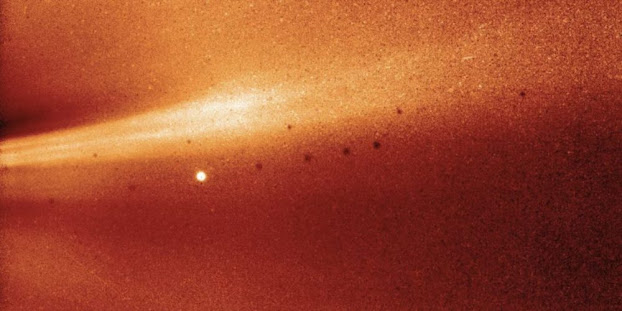NASA’s Parker Solar Probe is on a mission like no other spacecraft has ever attempted before.
Its currently speeding towards the sun to land the hottest ever high-five, effectively becoming the first spacecraft ever to attempt and ‘touch’ the sun.
On its way towards the Sun, the spacecraft has been gathering scientific data and snapping images.
This image was taken on Nov. 8, 2018, at 1:12 a.m. EST, and comes from the Parker Solar Probe’s WISPR (Wide-Field Imager for Solar Probe) instrument. Image Credit: NASA/Naval Research Laboratory/Parker Solar Probe. (That faint dot, seen in the middle of Mercury, is most likely part of the background corrections made in the image.)
In October and November, the Parker Solar Probe crossed the Corona, the super-hot atmosphere surrounding the sun. And while it was making history, it decided it would be a good idea to photograph what it was seeing.
The result? A stunning, never-before-seen image ‘inside’ the sun.
The photograph was captured by the probe’s WISPR (Wide-field Imager for Solar Probe) instrument when the spacecraft traveled at a distance of 16.9 million miles from the sun, inside our star’s corona.
The image shows distinct jets of solar material, dubbed coronal streamers, seen to the left/center of the image.
The bright spot you see in the above image is Mercury.
NASA explains that the black spots near planet Mercury are ‘artifacts’ of background correction.
The probe is a mere four months old, and while its still a baby ‘spacecraft’, it has already had a busy mission life.
Before it made its way towards the sun, on September 19, 2018, the probe snapped the first images from space, confirming that all its instruments were working flawlessly.
In October, the spacecraft already began breaking records.
It smashed two long-standing records becoming the closest human-made object ever to approach the sun and becoming the fastest spacecraft in history.
Parker Solar Probe is named after Eugene Parker, the physicist who first proposed the solar wind’s existence — the Sun’s constant outpouring of material — in 1958.
“This is the first NASA mission to be named for a living individual,” said Nicola Fox, director of the Heliophysics Division at NASA Headquarters in Washington.
“Gene Parker’s revolutionary paper predicted the heating and expansion of the corona and solar wind. Now, with Parker Solar Probe, we can truly understand what drives that constant flow out to the edge of the heliosphere.”



